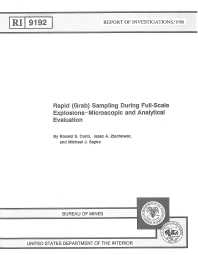Mining Publication: Rapid (Grab) Sampling During Full-scale Explosions - Microscopic and Analytical Evaluation
Original creation date: January 1988
The Bureau of Mines has developed a system using a high-speed electropneumatic mechanism for the rapid (grab) sampling of dusts and gases during an explosion. The sampling system consists of an aluminum housing that incorporates two 30-cm3 preevacuated glass vials with rubber septums. Upon actuation, the sampling probe needle is driven through the septum with a pressurized air pulse, filling the tube with gas and dust from the mine explosion. After a predetermined time, the sampling probe needle is retracted by a second high-pressure air pulse to its normal (quiescent) state, allowing the sampling tube to reseal. The onset and the duration of sampling are independently variable and controlled by a time-delay relay package. This technique enables the monitoring of pyrolysis-charring in coal particles and the generation and combustion of the pyrolysis vapors in both large- and small-scale explosions. The following results were obtained from full-scale dust explosion tests at the Bureau of Mines Lake Lynn Laboratory: (1) gas sampling of the leading edge of the flame front shows the large concentration changes, characteristic of the flame front; (2) gas samples taken entirely in the flame zone consist of pyrolysis and combustion products with very low residual oxygen; and (3) the particles collected in the flame zone show signs of extensive pyrolysis and charring.
Authors: RS Conti, IA Zlochower, MJ Sapko
Report of Investigations - January 1988
NIOSHTIC2 Number: 10006240
U.S. Department of the Interior, Bureau of Mines. Report of Investigations 9192, NTIS No. PB90-268756, 1988; :1-17
See Also
- A 20-Liter Furnace Test Method to Determine the Combustion Gas Toxicity of Conveyor Belts
- Evaluation of the Bagged Stone Dust Barrier Effectiveness in a Bord and Pillar Mine
- Experimental Mine and Laboratory Dust Explosion Research at NIOSH
- Explosion Temperatures and Pressures of Metals and Other Elemental Dust Clouds
- Initial Study of Buried Communication Cable for Underground Mines
- The Modified Direct Method: A Solution for Obtaining Accurate Coal Desorption Measurements
- Optically Powered Remote Gas Monitor
- Refuge Chamber Expectations Training - 1.0
- A Review of Recent Accidents Involving Explosives Transport
- Technology News 490 - An Inexpensive Device for Monitoring Explosions in Sealed Areas of Underground Mines
- Content source: National Institute for Occupational Safety and Health, Mining Program


 ShareCompartir
ShareCompartir
